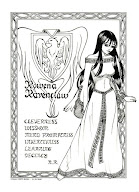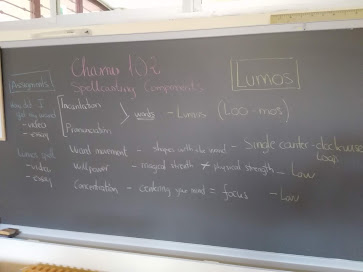Segunda clase del cuarto año en la clase de Historia de Hogwarts y vamos a aprender un poco más sobre los fundadores de las cuatro casas. Para ello vemos unos vídeos y luego leemos un texto. Después
https://www.youtube.com/watch?v=sdJ8n3IUUQs
https://www.youtube.com/watch?v=xNJW1ZmaHSE
https://www.youtube.com/watch?v=C1QpDCcS_JI
https://www.youtube.com/watch?v=VbLBMzTO8eg
Welcome
back to Hogwarts History class! I see you survived your first lesson and assignment. It
wasn’t too terrible, I hope. I’m sure you all did well, and please feel free to
come to me if you have any questions at all. I want to help you make sure that
you have a solid understanding of the material covered in this course and I am
more than happy to assist anyone. Starting today, each lesson will build off of
one another in order to allow you to be able to complete a full reading by the
end of the term. It is important that you pay attention to everything that is
discussed, and remember what we study from lesson to lesson. We will continue learning about the four witches and wizards that founded our magical school. So I recommend you to follow the diretions provided by the book designed for this year.
History of Hogwarts 402. Hogwarts founders
Godric Gryffindor
The
founder of Gryffindor house. A fair man, he believed that any child who
displayed magical abilities before their 11th birthday should be able to attend
Hogwarts. Godric valued courage and bravery, believing these were the two most
virtuous abilities a person can possess. Gryffindor was the original owner of
the Sorting Hat, which he and his fellow founders enchanted to select people to
be sorted into their houses, by seeing the qualities each founder valued the
most.
Gryffindor
also had a sword made, which would present itself to any true Gryffindor in a
moment of need. The sword became an important item a thousand years later, and
was instrumental in defending Hogwarts from Slytherin's descendant. He was
allegedly the best friend of Slytherin before he left Hogwarts. His house
corresponds to the element of fire.
Helga Hufflepuff
The
founder of Hufflepuff house. A kind and warm woman, she valued a person must
possess to be sorted into Hufflepuff house are those of loyalty, patience, and
hard working above all else. It is also known that she brought the house-elves
to Hogwarts. She owned a fine golden cup which was fairly innocuous aside from
being her possession. The cup was sought by Lord Voldemort nearly a thousand
years later, for him to turn it into a Horcrux. She was the best friend of
Rowena Ravenclaw. Her house corresponds to the element of earth.

Rowena Ravenclaw
The
founder of Ravenclaw house. A sharp and intelligent woman, Intellect is a
highly valued asset to the students of Ravenclaw house. Due to this, it is
likely that Rowena wanted to make Hogwarts the very finest Wizarding school on
earth, teaching those children with the highest intelligence. Rowena also had a
daughter, Helena, who later became the Grey Lady of Hogwarts as a ghost.

Helena
stole her mother's diadem, and it became lost. It was believed to have been
lost for so long, that no one alive had seen it, however, it had actually been
found by Lord Voldemort with the aid of the ghost of Ravenclaw's daughter. He
turned it into a Horcrux and later hidden once more, this time within the Room
of Requirement, where it would remain hidden for at least 50 years. She was the
best friend of Helga Hufflepuff. Her house corresponds to the element of air.
Salazar Slytherin
The
founder of Slytherin house. Sly and cunning, he was not unlike many of the
students he brought into his house. He believed strongly that only wizards of
pure blood (i.e., those with a mother and father from wizarding families)
should be allowed to attend Hogwarts. Slytherin caused great dispute over this
with the other founders, and it eventually caused a permanent rift with
Gryffindor, which led to Slytherin's departure from the school. Before he left,
however, he created the Chamber of Secrets, complete with a huge statue of
himself and a horrible monster.
Almost
a thousand years later, Slytherin's descendant, Lord Voldemort, would seek to
fulfil his desires of banishing Muggle-borns from Hogwarts, and exterminating
them. One of his personal effects, a locket, was later claimed by Voldemort, to
be used as a Horcrux. He was the best friend of Godric Gryffindor before the
rift occurred and he left Hogwarts. His house corresponds to the element of
water.


















































